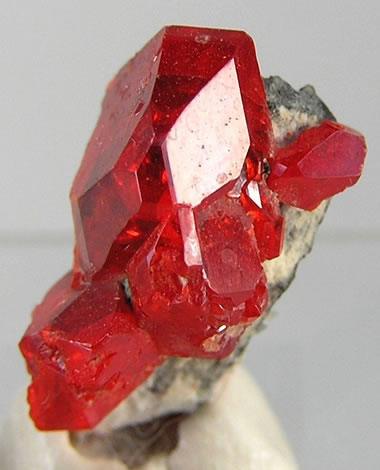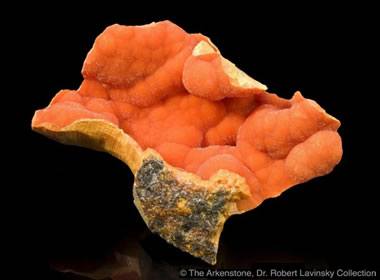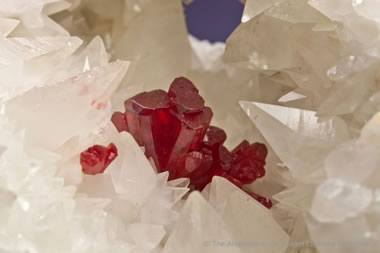Home » Minerals » Realgar and Orpiment
Realgar and Orpiment
Arsenic Sulfide Minerals
Article by: Hobart M. King, PhD

Realgar: Realgar crystals from the Royal Reward Mine in King County, Washington. Specimen measures about 2.2 x 1.1 x 0.8 centimeters. Specimen and photo by Arkenstone / www.iRocks.com.
Toxic Arsenic Sulfide Minerals
Realgar and orpiment are very similar minerals. They are both arsenic sulfides and members of the monoclinic crystal system. They form in the same geological environments and can be closely associated in the same deposits. They have similar physical properties and similar histories of use by man. Because of these similarities, we decided to describe realgar and orpiment in a single article.
Realgar and orpiment are both toxic minerals, and contact with them should be avoided. They are not suitable for classroom specimens.
Physical Properties: Realgar / Orpiment | ||
| Realgar | Orpiment | |
| Chemical Classification | Sulfide | Sulfide |
| Color | Red to orange, gray | Yellow, golden, yellow-brown |
| Streak | Red-orange to red | Light yellow |
| Luster | Resinous to pearly on cleavage | Resinous to pearly on cleavage |
| Diaphaneity | Translucent to transparent | Translucent to transparent |
| Cleavage | Good | Perfect |
| Mohs Hardness | 1.5 to 2 | 1.5 to 2 |
| Specific Gravity | 3.56 | 3.49 |
| Diagnostic Properties | Color, streak, resinous luster. Association with orpiment. | Color, streak, luster, foliated appearance. Association with realgar. |
| Chemical Composition | As4S4 | As2S3 |
| Crystal System | Monoclinic | Monoclinic |
| Uses | An ore of arsenic. Historically used as a pigment, depilatory, poison, ingredient in explosives and fireworks, ritualistic "medicine," cosmetic. | An ore of arsenic. Used in the production of oil cloth, semiconductors, photoconductors. Historically used as a pigment, poison, ingredient in fireworks and explosives. |
What is Realgar?
Realgar is a monoclinic arsenic sulfide mineral with a brilliant red color and a chemical composition of As4S4. Well-formed realgar crystals can look so much like red gemstones that the mineral was often called "ruby sulfur" and "ruby arsenic."
However, realgar is not used as a gemstone because it is very soft, with a Mohs hardness of just 1-1/2 to 2. It is easily ground into a fine, bright red powder. Those properties caused it to become a favorite pigment in many parts of the ancient world. It was traded over great distances to make paints, inks, and dyes - until people realized that it was toxic.
The arsenic in realgar was the source of its toxicity. After its toxicity was realized in the Middle Ages, the mineral was used as a poison to kill rodents, insects, and weeds. Realgar was also used in leather processing to remove the hair from hides. Today it is rarely used for any of these purposes because more effective and less toxic substitutes have been developed. However, some use of realgar in ritualistic cosmetics and "medicines" continues in a few parts of the world. Today the main use of realgar is as an ore of arsenic metal.
The chemical formula of realgar is often written as As4S4 instead of the simpler AsS. This is done because As4S4 represents a structural unit of the mineral. A compound of As+3 and S-2 would be out of electrical balance. In realgar, three of the arsenics are joined in a chain by covalent bonds. This gives the arsenics an effective electrical charge of +8. That combines with four S-2 ions to produce an electrically neutral molecule. This is why realgar's chemical composition is often presented as As4S4 instead of AsS.

Orpiment: Bright orange orpiment from the Jiepaiyu Mine in Hunan Province, China. This specimen shows the botryoidal habit of orpiment. It measures 12.7 centimeters in length. Specimen and photo by Arkenstone / www.iRocks.com.

The best way to learn about minerals is to study with a collection of small specimens that you can handle, examine, and observe their properties. Inexpensive mineral collections are available in the Geology.com Store. Image copyright iStockphoto / Anna Usova.
What is Orpiment?
Orpiment is a monoclinic arsenic sulfide with a yellow-orange color and a chemical composition of As2S3. It has a Mohs hardness of 1-1/2 to 2 and is easily ground into a yellow to yellow-orange powder. Like realgar, its earliest widespread use was as a pigment for paints, inks, and dyes, and it was traded over great distances.
After its toxicity was discovered, its use as a pigment declined. People took advantage of its toxicity to use it as a poison for insects and rodents. Some people continued to use it as a ritualistic cosmetic and "medicine" even after its toxicity was known, and that practice continues today in some parts of the world.
Today the primary use of orpiment is as an ore of arsenic. It is also used in manufacturing oil cloth, semiconductors, and photoconductors.

Realgar on calcite: Red realgar crystals on white calcite, from the Jiepaiyu Mine in Hunan Province, China. Specimen and photo by Arkenstone / www.iRocks.com.
Geologic Occurrence
Realgar and orpiment are mainly found associated with hydrothermal and volcanic activities. They are sublimation products at volcanic vents and crystallization products at hot springs. These are among the earliest deposits exploited in the middle ages. Underground deposits of realgar and orpiment are in veins and fractures. There they are associated with lead, silver, gold, and other arsenic minerals.
| More Minerals |
 |
Herkimer Diamonds |
 |
The Acid Test |
 |
Tumbled Stones |
 |
Zircon |
 |
Fool*s Gold |
 |
Kyanite |
 |
Rock Tumblers |
 |
Rhodochrosite |

Find Other Topics on Geology.com:

|

| ||

|

| ||

|

| ||

|

|
